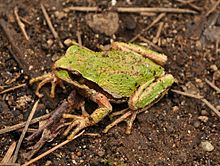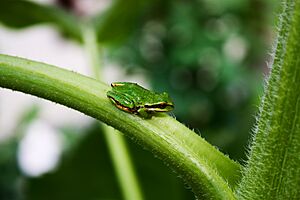Pacific tree frog facts for kids
Quick facts for kids Pacific Tree Frog |
|
|---|---|
 |
|
| Conservation status | |
| Scientific classification | |
| Kingdom: | |
| Phylum: | |
| Class: | |
| Order: | |
| Family: | |
| Genus: |
Pseudacris
|
| Species: |
P. regilla
|
| Subspecies: |
see text
|
| Binomial name | |
| Pseudacris regilla (Baird & Girard, 1852)
|
|
| Synonyms | |
|
Hyla regilla |
|
The Pacific Tree Frog (Pseudacris regilla) is a small tree frog. It lives along the West Coast of North America. You can find these frogs in California, Oregon, and Washington state. They also live in British Columbia, Canada, and parts of Idaho.
These amazing frogs usually live on the ground. But some have been found high up in mountains, even 10,000 feet above sea level! They are known for their loud "ribbit" sound. They are often green or brown, and they can even change their colors!
Contents
Pacific Tree Frog: Body & Appearance
The Pacific tree frog can grow up to 2 inches long. That's about the size of your thumb! Male frogs are usually smaller than females. Males also have a dark patch on their throats. This patch is a vocal sac, which puffs out when the male calls.
These frogs come in many colors. They can be green, tan, reddish, gray, brown, cream, or even black. Most are a shade of green or brown. Their bellies are usually pale or white.
They have dark stripes or spots on their backs and sides. A key way to spot them is a black or dark brown stripe. This stripe goes from their nose, across their eye, and back to their shoulder. They can change their color with the seasons. This helps them blend in with their surroundings. Their skin feels a bit bumpy.
Pacific tree frogs have long, slender legs. Their toes are long and only slightly webbed. Each toe has a round, sticky pad. These pads help them climb and stick to surfaces. Male frogs also have a small extra toe on their outer thumbs. They use this toe only when mating.
Where Pacific Tree Frogs Live
Pacific tree frogs are very common along the Pacific coast. You can find them from northern California all the way to British Columbia. They also live in Idaho. A small group was even brought to an island in Alaska in the 1960s.
They live in many different places. You can find them near ponds, streams, and lakes. They also live in forests, grasslands, and even in city backyards. They can survive in many climates, from sea level to high mountains. Sometimes, other animals like rough-skinned newts eat their eggs.
Reproduction and Life Cycle
Pacific tree frogs start mating in early winter to early spring. The exact time depends on where they live. When it's time, male frogs move to the water. They make a very loud "ooh-yeeh" or "ribbit" sound all at once. This sound attracts female frogs to the water for mating.
Female frogs lay their eggs in groups of 10 to 90. They usually place them on or under plants and leaves in calm, shallow water. If the eggs survive, tiny tadpoles hatch in one to three weeks.
Tadpole Development
Tadpoles eat tiny plants like algae and diatoms from the water's surface. They use a special beak-like mouth to scrape food. After about two to two and a half months, tadpoles change into frogs. This change is called metamorphosis. Sometimes, tadpoles might delay this change for up to five months.
During the last part of their change, tadpoles grow four legs and their tail shrinks. They stop eating for a short time. Their mouths get wider, and their bodies get ready to eat meat instead of plants.
Behavior and Diet
Pacific tree frogs are mostly active at night. But you might spot them during the day too. They often hide under logs, rocks, tall grass, or leaves. This makes them very hard to see unless they move.
When they hunt, their sticky toe pads help them climb plants. They wait to ambush their prey. Their diet includes spiders, beetles, flies, ants, and other insects. They can even eat insects almost as big as they are! They stretch their bodies a bit to swallow large meals.
These frogs grow up quickly. They can usually mate the year after they change from tadpoles to frogs. Many animals hunt them, including snakes, raccoons, herons, and other small animals.
When they sense food nearby, they sometimes twitch a toe. This attracts insects close enough for them to catch with their tongues. In captivity, these frogs can live up to 9 years.
Frog Calls
Pacific tree frogs make several different sounds. Males make an "advertisement call," which sounds like "ribbit" or "crek-ek." This call is very loud and can be heard from far away. Males also make an "encounter trill call." They have a "dry land call" too, which is a long "cre-ee-ee-eeek." You can hear this call almost any time of year. Pacific tree frogs are the most commonly heard frogs along the West Coast of the United States.
Green and Brown Color Changes
These frogs can change their color from brown to green. Scientists used to think adult frogs were stuck with one color. But now we know some can switch between green and brown. They can also become lighter or darker. They can even change from having patterns to being a solid color, or vice versa. Sometimes, they show a mix of colors, with brown and green being the most common.
These color changes are not caused by the colors around them. Instead, they are triggered by how bright their surroundings are. This happens with the changing seasons. A full color change can take weeks or months. But small changes can happen in just a few hours. This ability helps them hide from predators.
Frog skin color comes from special cells called chromatophores. There are three main types in amphibians:
- Xanthophores: These cells are at the top. They hold yellow, orange, or red colors.
- Iridophores: These are below the xanthophores. They reflect and scatter white light upwards. For Pacific tree frogs, iridophores reflect blue light. This blue light mixes with the yellow from the xanthophores to make the frog look green.
- Melanophores: These are the deepest cells. They create black and brown colors.
A very rare "blue morph" Pacific tree frog exists. This is caused by a genetic change. It might stop the xanthophores from making yellow color. So, a frog that would normally be green appears blue instead. One of these rare blue frogs lives at the Humboldt State University Natural History Museum in California.
Homing Instincts
Scientists have studied Pacific tree frogs to see if they can find their way home. They wanted to know how frogs remember where their home pond is. Researchers marked frogs and moved them about 300 yards away from their pond. A few days later, they checked the original pond. More than 66% of the frogs had returned!
In another test, 24 frogs were put into a larger pond. 20 of those frogs found their way back to their original pond. This shows that Pacific tree frogs have a strong homing instinct. Scientists think they might use their sense of smell, hearing, and body movements to find their way. It's likely they use a combination of these senses to get back home.
Images for kids
See also
 In Spanish: Pseudacris regilla para niños
In Spanish: Pseudacris regilla para niños







